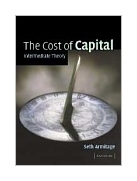|
||
• wydawnictwa polskie
• Zamów informacje o nowościach z wybranego tematu • kontakt
• Cookies na stronie |
THE COST OF CAPITAL INTERMEDIATE THEORYARMITAGE S.wydawnictwo: CAMBRIDGE , rok wydania 2005, wydanie Icena netto: This book provides an answer to the question, What does the finance and economics literature say about the determination and estimation of a project's cost of capital?. Uniquely, it reviews both the theory of asset pricing in discrete time and a range of more applied topics which relate to project valuation, including the effects of corporate and personal taxes, the international dimension, estimation of the cost of equity in practice, and the cost of capital for regulated utilities. It seeks to explain models and arguments in a way which does justice to the reasoning, whilst minimising the prior knowledge of finance and maths expected of the reader. It acts as a bridge between a general undergraduate or MBA text in finance, accounting or economics, and the modern theoretical literature on the cost of capital. Unique focus on the cost of capital alone, thus making a much needed contribution to corporate finance Only text book which reviews theory on the cost of capital at an intermediate level Reviews both pure asset pricing theory and applied theory such as the effects of taxes Table of Contents Preface; Part I. Expected Returns on Financial Assets: 1. The cost of capital under certainty; 2. Allowing for uncertainty: contingent states; 3. The capital asset pricing model and multifactor models; 4. The consumption-based model; 5. The equity risk premium; Part II. A Project's Cost of Capital: 6. Project valuation; 7. Corporation tax, leverage and the weighted average cost of capital; 8. Personal tax and the cost of equity: the old and the new views; 9. Personal tax, leverage and multiple tax rates; 10. Inflation and risk premiums; 11. The international dimension; Part III. Estimating the Cost of Capital: 12. The cost of equity: inference from present value; 13. The cost of equity: applying the CAPM and multifactor models; 14. Estimating a project's cost of capital; 15. Regulated utilities. 352 pages
Po otrzymaniu zamówienia poinformujemy, |


